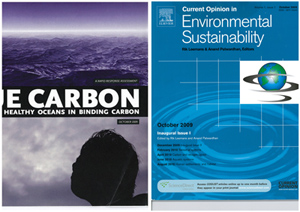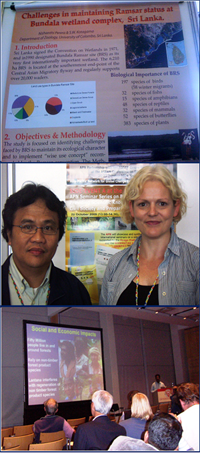As one of the sponsoring organisations of the DIVERSITAS (International Programme of Biodiversity Science) Second Open Science Conference (OSC2), APN is very pleased that the Conference convened successfully in Cape Town, South Africa on 13-16 October 2009. On behalf of the APN, Dr. Linda Anne Stevenson, Scientific Officer participated at the OSC2 and below narrative provides highlights of the Conference and APN’s active participation.
Meeting of the National Committees: A closed meeting of the national and regional committees of DIVESRITAS was held on 13 October 2009. APN attended this meeting upon invitation as a regional committee representative of DIVERSITAS. The APN was highlighted during this meeting as an important partner for biodiversity in the Asia-Pacific region.There was a call to strengthen the regional representation of Biodiversity in Africa from the National Research Foundation of South Africa and this was well noted by everyone. The main goal of this meeting was to discuss a number of issues related to the role of the national and regional committees of DIVERSITAS and the need to empower current committees of DIVERSITAS in terms of the role they play within DIVERSITAS at the national/regional and global levels. Further, the new draft strategic plan for DIVERSITAS, expected to be launched sometime in 2010, was distributed for comments and suggestions. The main controversy with the new strategic plan was its holistic perspective encouraging interdisciplinary science, which is more policy- and socio-economically relevant.
Conference Overview: The OSC2 was attended by almost 600 scientists from across the global, approximately 9% of whom were from Asia and Oceania. The Pacific Island Countries, unfortunately, were noticeably absent at the Conference. The title of the conference was BIODIVERSITY and SOCIETY: Understanding Connections.
The Key Message?
“The world will miss its agreed target to stem biodiversity loss by next year.”
This appeared to be the key message captured by the media following the open ceremony of the conference, a message that seemed to capture the attention not only of the approximate 600 expert participants, but by the global community in general. In his plenary address, Prof. Harold Mooney, Stanford University, USA, and Chair of the DIVERSITAS Scientific Committee noted that, “A great deal of awareness-raising is still much needed with respect to the planetary threat posed by the loss of so many species. The focus of biodiversity science today, though, is evolving from describing problems to policy-relevant problem solving.“
During the conference, which was packed with hundreds of oral and poster presentations that were delivered during numerous symposia, oral, poster and plenary sessions, key biodiversity issues were discussed including economics, science-policy issues, links to climate change, agro biodiversity, management, governance, conservations and ecosystem functioning. Also highlighted was the development of DIVERSITAS core projects of bioGENESIS, ecoSERVICES, ecoHEALTH, bioSUSTAINABILITY, GMBA (Global Mountain Biodiversity Assessment), agroBIODIVERSITY and freshwaterBIODIVERSITY.
In addition, five Science-Policy Roundtable Sessions were convened between top science and policy specialists on mainstream topics including the recent effort to create a science-based global biodiversity observing system – Group on Earth Observations Biodiversity Observation Network (GEO-BON), under the GEO/GEOSS (Global Earth Observation System of Systems) framework, to improve both coverage and consistency in observations at ground level and via remote sensing. DIVERSITAS Vice-Chair Prof. Robert Scholes, who heads GEO-BON and highlighted that GEO-BON will help give a comprehensive baseline against which scientists can track biodiversity trends and evaluate the status of everything from genes to ecosystem services. The lack of such information became acutely apparent during preparation of the Millennium Ecosystem Assessment, and in formulating the Convention on Biological Diversity (CBD)’s 2010 targets.
Another notable roundtable session focused on the creation of an international mechanism to unify the voice of the biodiversity science community to better inform policy-making, with its function similar to that of the International Panel on Climate Change (IPCC). The previous week in Nairobi, Environment Ministers from countries all over the world considered the creation of such a body to be called IPBES (the Intergovernmental Science-Policy Platform on Biodiversity and Ecosystem Services), which will require United Nations (UN) General Assembly approval. There was cautious optimism among the conference participants as well as those present that had participated in the Nairobi meeting, that IPBES would be realised in 2010, the International Year of Biodiversity. Said Dr. Anne Larigauderie, Executive Director of DIVERSITAS, “ It will be like a dream come true, but it will also challenge scientists to become much better at conveying science to policy-makers.”
 Publication Launches : Two key publications were launched at the OSC2 which will be of tremendous importance to all global change stakeholders at the science, policy and societal levels. The first is the new Elsevier Journal “Current Opinion in Environmental Sustainability,” edited by Rik Leemans and Anand Patwardhan. The other is a Rapid Assessment Response Report, “Blue Carbon – The Role of Healthy Oceans in Binding Carbon,” the objective of which is to highlight the critical role of the oceans and ocean ecosystems in maintaining climate and in assisting policy-makers mainstream an oceans agenda into national and international climate change initiatives.
Publication Launches : Two key publications were launched at the OSC2 which will be of tremendous importance to all global change stakeholders at the science, policy and societal levels. The first is the new Elsevier Journal “Current Opinion in Environmental Sustainability,” edited by Rik Leemans and Anand Patwardhan. The other is a Rapid Assessment Response Report, “Blue Carbon – The Role of Healthy Oceans in Binding Carbon,” the objective of which is to highlight the critical role of the oceans and ocean ecosystems in maintaining climate and in assisting policy-makers mainstream an oceans agenda into national and international climate change initiatives.
 APN Visibility : APN was highly visible at the conference and was able to showcase APN at an exhibition booth, which was set up in one of the main ballrooms displaying posters; and at a side-event, which had been organised to ensure that APN had an opportunity to meet with APN travel grantees. The APN provided a presentation during the side-event session and, in particular, discussed the biodiversity-related activities being undertaken as well as the proposals process and training workshops for developing APN proposals.
APN Visibility : APN was highly visible at the conference and was able to showcase APN at an exhibition booth, which was set up in one of the main ballrooms displaying posters; and at a side-event, which had been organised to ensure that APN had an opportunity to meet with APN travel grantees. The APN provided a presentation during the side-event session and, in particular, discussed the biodiversity-related activities being undertaken as well as the proposals process and training workshops for developing APN proposals.
In what was deemed an overwhelmingly successful conference thanks to the highly skilled DIVERSITAS Secretariat headed by Dr. Anne Larigauderie, and the Cape Town Organising Committee, led by Prof. Bob Scholes, the following sombre message by Vice-Chair of the Scientific Committee of DIVERSITAS, Prof. Georgina Mace, was echoed throughout the conference and will remain very much at the Biodiversity forefront as we move into 2010, expected to be a landmark year for international biodiversity issues:
We will certainly miss the target for reducing the rate of biodiversity loss by 2010. It is hard to imagine a more important priority than protecting the ecosystem services underpinned by biodiversity.
Biodiversity is fundamental to humans having food, fuel, clean water and a habitable climate.Yet changes to ecosystems and losses of biodiversity have continued to accelerate. Since 1992, even the most conservative estimates agree that an area of tropical rainforest greater than the size of California has been converted mostly for food and fuel. Species extinction rates are at least 100 times those in pre-human times and are expected to continue to increase.
Formal Conference Statement: As we approach the 2010 Year of Biodiversity, the OSC2 confirms that the fabric out of which the Earth system is woven is unravelling at an accelerating rate. At the same time, we are discovering ever more about biodiversity and the benefits it provides to people. It is clear that biodiversity loss erodes the integrity of ecosystems and their capacity to adapt in a changing world. It represents a serious risk to human wellbeing and a squandering of current assets and future opportunities.
The biodiversity scientists gathered here commit themselves to finding practical solutions to this problem. They will do so by: increasing shared knowledge of biodiversity and its functions; helping to develop systems for monitoring the biodiversity of the planet; and being responsive to the knowledge needs of society with clear communication of findings.
We welcome the proposed mechanism for the ongoing evaluation and communication of scientific evidence on these issues – the Intergovernmental Platform on Biodiversity and Ecosystem Services (IPBES). We call on governments to establish IPBES as soon as possible and we encourage all scientists to lend their full support. We urge policy-makers to act swiftly and effectively on the already-established and future findings relating to ways of limiting further biodiversity loss and restoring ecosystem services.
Meeting current and future human needs must make adequate provision for the complex web of life of which people are an integral part. People everywhere must give effect to their shared desire for a biologically-rich and productive planet through their individual decisions and actions.
The conference programme and book of abstracts can be downloaded at the following websites, respectively
http://www.diversitas-osc.org/docs/Diversitas%20Programme%20final.pdfhttp://www.diversitas-osc.org/docs/Abstract%20intreactive%20final.pdf